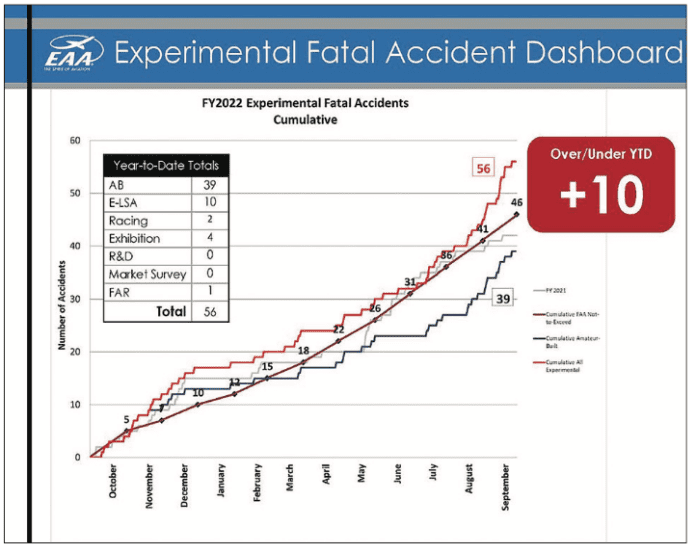New data from the Experimental Aircraft Association (EAA) show that fatal accidents involving experimental aircraft—homebuilts and others—were up sharply during the federal fiscal year ending September 30, to 56. In FY2021, the number of fatals was 42. The new numbers come from the FAA’s ongoing data tracking.
“The fatal accident totals, for both amateur-builts and experimental aircraft overall, remain 30 to 35 percent below where they were just a decade ago, including when looking at the three-year rolling average on which the FAA bases its annual not-to-exceed number,” said Sean Elliott, EAA’s vice president of advocacy and safety. “While that’s good news, we never want to see an annual increase in the totals. That’s a reminder that we all must continue to work to make safety the top priority even with the small numbers we see each year.”
According to EAA, “The higher accident totals in experimental category aircraft mirror an increase for all of general aviation over the same 12-month period. This also coincides with preliminary figures that show an increase in flight hours in 2021 and into 2022.”
“EAA has been deeply involved in FAA’s safety analysis teams for several years, and we consistently see that experimental aircraft accident causes are very similar to accident causes for all GA accidents,” Elliott said. “It shows that the accidents overwhelmingly do not occur because a pilot is flying an amateur-built or experimental aircraft, but because of factors relating to pilot decision making or flight procedures. Those are areas where EAA safety programs and resources can make a difference.”
The association’s efforts to reduce accidents have included working closely with the FAA and NTSB on recommendations to reduce fatal accidents through the FAA General Aviation Joint Safety Committee. The EAA also has developed and distributed thousands of copies of its Flight Test Manual and advocated using a safety pilot during initial flight testing in amateur-built aircraft. The graph below provides additional detail on the FY2022 fatal accidents involving experimental aircraft.
Garmin GFC 500 Autopilots And Trim Runaways
The FAA’s Safety Team (FAASTeam) in late November published a notice advising that Garmin “has identified an issue with GFC 500 autopilots with optional auto trim” that “may result in an uncommanded automatic trim runaway when the autopilot is first engaged.”
According to the notice, “Garmin Service Alert 22109 Revision A requires operators of certified installations to pull and collar the autopilot circuit breaker and placard the autopilot as ‘inoperative’ prior to further flight.” The company expects a Q42022 software update will resolve the issue.
Safety Pilots Now Can Use BasicMed
A recent FAR 61 rule change primarily affecting commercial balloon pilots also expands the privileges for those flying under the FAA’s BasicMed medical certification by allowing them to act as safety pilots. The new rule allows a required flightcrew member who is not acting as pilot in command to do so with BasicMed certification. Previously, the FAA did not allow using BasicMed when acting as a safety pilot.
“AOPA appreciates the FAA’s amendment to allow persons who operate under BasicMed to serve as a required pilot flight-crewmember when not acting as PIC,” said AOPA Senior Director of Regulatory Affairs Christopher Cooper. “We also appreciate the FAA’s continued support for and expansion of BasicMed.”




